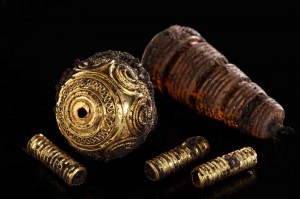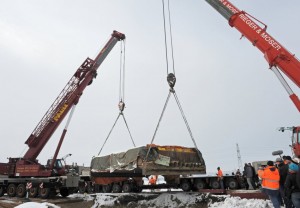Experts at the State Office for the Preservation of Monuments in Stuttgart have been studying the intact 2600-year-old Celtic tomb found in the ancient fort town of Heuneburg in the north Danube region of Germany. The burial chamber was found in December of last year, and it was in such a remarkable state of preservation that the entire 80-ton chunk of soil in which it was embedded was cut out, lifted by crane and transported whole to the lab in Stuttgart on a flatbed truck.
 The elaborate jewelry found when a small part of the grave was first discovered dated the tomb to the 7th century B.C., the early period of Celtic habitation, and suggested it contained the remains of a noblewoman of some status. Now that some of the lab work has been done, both of those early conclusions are confirmed. The skeletal remains of a woman were indeed within the burial chamber and dendrochronological analysis dates the tomb to just over 2600 years ago. The remains of a child were also buried inside.
The elaborate jewelry found when a small part of the grave was first discovered dated the tomb to the 7th century B.C., the early period of Celtic habitation, and suggested it contained the remains of a noblewoman of some status. Now that some of the lab work has been done, both of those early conclusions are confirmed. The skeletal remains of a woman were indeed within the burial chamber and dendrochronological analysis dates the tomb to just over 2600 years ago. The remains of a child were also buried inside.
The archaeologists are excited because this grave was preserved by the water-sodden soil of the region so that the oak of the floor was intact, for example, and that puts an exact date on it. The oak trees were felled 2,620 years ago, so, assuming they were felled for the grave, our lady died in 609BC.
The grave had also not been robbed down those 26 centuries, unlike many others.
This means that the jewellery is still there, particularly beautiful brooches of ornate Celtic design in gold and in amber.
The large number and quality of the jewels found not only show that the early Celts were elegantly adorned, but may even suggest an aristocratic hierarchy, a disputed point among historians. According to Dr. Dirk Krausse, the leader of the excavation, the wealth of the burial marks it as the oldest Celtic princely female grave ever discovered. It’s also the only princely grave with a wooden inner chamber, or least the only one lucky enough to have been waterlogged and preserved from decay for 26 centuries.
 The survival of organic materials is just as exciting, albeit less shiny. The unique opportunity to examine the whole burial chamber within a lab environment has allowed archaeologists to take it apart one grain of dirt at a time, using all kinds of cutting edge analytical tools in the process. One member of the archaeological team, Nicole Ebenger-Rest, has done the bulk of the excavation. She has found the adult woman’s teeth, as well as pieces of cloth and food. These materials might provide a wealth of information about how the early Celts lived.
The survival of organic materials is just as exciting, albeit less shiny. The unique opportunity to examine the whole burial chamber within a lab environment has allowed archaeologists to take it apart one grain of dirt at a time, using all kinds of cutting edge analytical tools in the process. One member of the archaeological team, Nicole Ebenger-Rest, has done the bulk of the excavation. She has found the adult woman’s teeth, as well as pieces of cloth and food. These materials might provide a wealth of information about how the early Celts lived.
The final report from the Stuttgart team is scheduled for release in June. There are tentative plans for the jewels and other grave goods found to go on display in Stuttgart next year as part of a “World of the Celts” exhibit.